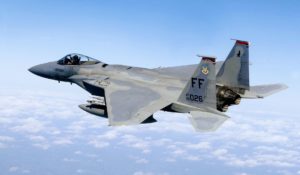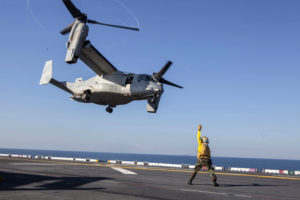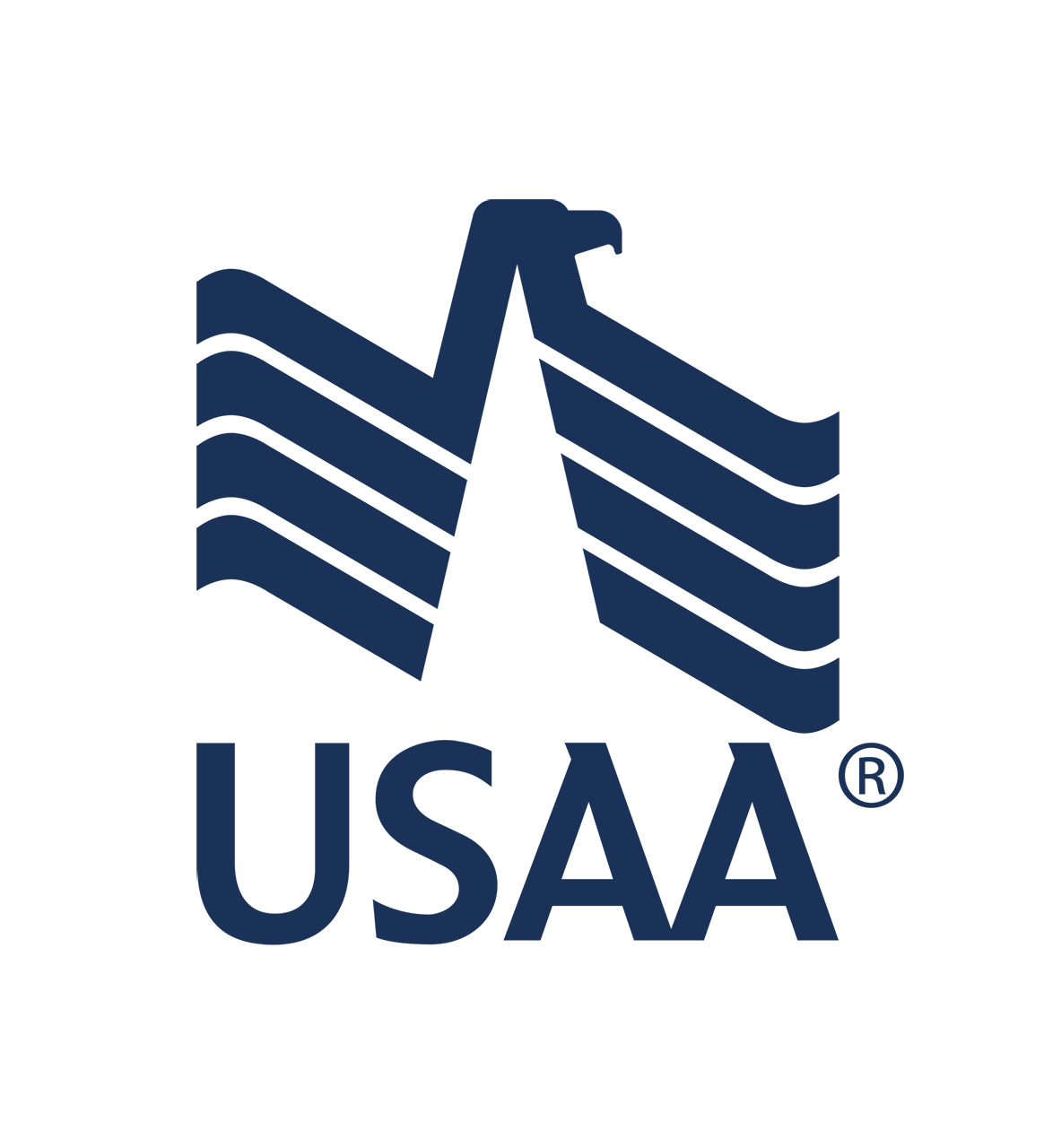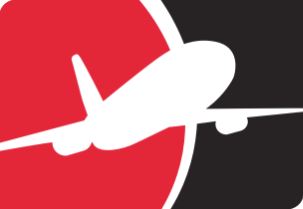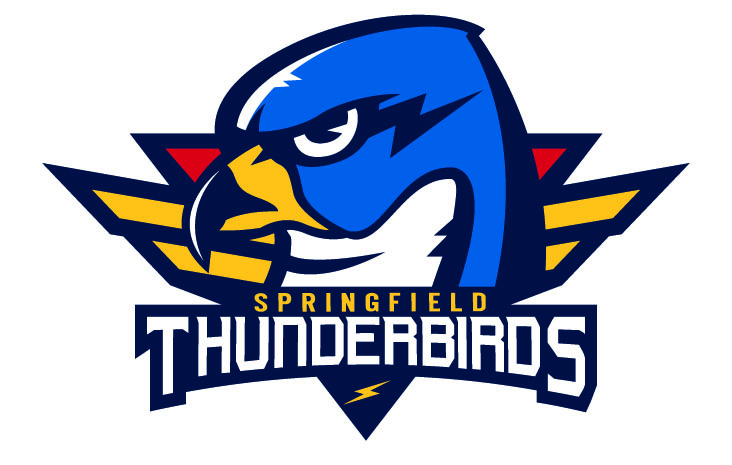Static Displays
“This section is updated as acts are confirmed. Please check back again soon for additions!”
C-5 Galaxy

The C-5 Galaxy is one of the largest aircraft in the world and the largest airlifter in the Air Force inventory. The aircraft can carry a fully equipped combat-ready military unit to any point in the world on short notice and then provide the supplies required to help sustain the fighting force.
The C-5 has a greater capacity than any other airlifter. It has the ability to carry 36 standard pallets and 81 troops simultaneously. The Galaxy is also capable of carrying any of the Army’s air-transportable combat equipment, including such bulky items as the 74-ton mobile scissors bridge. It can also carry outsize and oversize cargo over intercontinental ranges and can take off or land in relatively short distances.
Ground crews are able to load and off-load the C-5 simultaneously at the front and rear cargo openings, reducing cargo transfer times. The C-5 has the distinctive high T-tail, 25-degree wing sweep, and four turbofan engines mounted on pylons beneath the wings.
C-17 Globemaster III
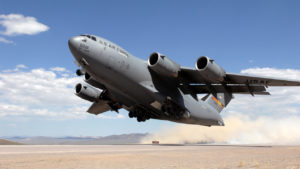 The C-17 Globemaster III is the newest, most flexible cargo aircraft to enter the airlift force. The C-17 is capable of rapid strategic delivery of troops and all types of cargo to main operating bases or directly to forward bases in the deployment area. The aircraft can perform tactical airlift and airdrop missions and can transport litters and ambulatory patients during aeromedical evacuations when required. The inherent flexibility and performance of the C-17 force improve the ability of the total airlift system to fulfill the worldwide air mobility requirements of the United State
The C-17 Globemaster III is the newest, most flexible cargo aircraft to enter the airlift force. The C-17 is capable of rapid strategic delivery of troops and all types of cargo to main operating bases or directly to forward bases in the deployment area. The aircraft can perform tactical airlift and airdrop missions and can transport litters and ambulatory patients during aeromedical evacuations when required. The inherent flexibility and performance of the C-17 force improve the ability of the total airlift system to fulfill the worldwide air mobility requirements of the United State
KC-135 Stratotanker
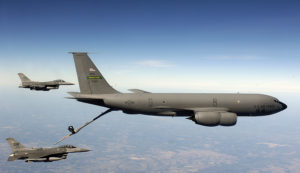
F-16 Fighting Falcons receive fuel from a KC-135 Stratotanker. (U.S. Air Force photo/Staff Sgt Suzanne Day)
Introduced in 1957, The KC-135 Stratotanker provides the core aerial refueling capability for the United States Air Force and has excelled in this role for more than 50 years. This unique asset enhances the Air Force’s capability to accomplish its primary mission of global reach. It also provides aerial refueling support to Air Force, Navy, Marine Corps and allied nation aircraft. The KC-135 is also capable of transporting litter and ambulatory patients using patient support pallets during aeromedical evacuations. Four turbofans, mounted under 35-degree swept wings, power the KC-135 to takeoffs at gross weights of up to 322,500 pounds. A cargo deck above the refueling system can hold a mixed load of passengers and cargo. Depending on fuel storage configuration, the KC-135 can carry up to 83,000 pounds of cargo.
Nearly all internal fuel can be pumped through the flying boom, the KC-135’s primary fuel transfer method. One crewmember, known as the boom operator, is stationed in the rear of the plane and controls the boom during in-flight air refueling.
A special shuttlecock-shaped drogue attached to and trailing behind the flying boom may be used to refuel aircraft fitted with probes. Some aircraft have been configured with the multipoint refueling system, which consists of special pods mounted on the wingtips. These KC-135s are capable of refueling two receiver aircraft at the same time.
The AC-130J Ghostrider

The AC-130J Ghostrider’s primary missions are close air support, air interdiction and armed reconnaissance. Close air support missions include troops in contact, convoy escort and point air defense. Air interdiction missions are conducted against preplanned targets or targets of opportunity and include strike coordination and reconnaissance and overwatch mission sets. The AC-130J will provide ground forces an expeditionary, direct-fire platform that is persistent, ideally suited for urban operations and delivers precision low-yield munitions against ground targets.
The AC-130J is a highly modified C-130J aircraft that contains many advanced features. It contains an advanced two-pilot flight station with fully integrated digital avionics. The aircraft is capable of extremely accurate navigation due to the fully integrated navigation systems with dual inertial navigation systems and global positioning system. Aircraft defensive systems and color weather radar are integrated as well. The aircraft is capable of air refueling with the Universal Air Refueling Receptacle Slipway Installation system.
Additionally, the AC-130J is modified with the Precision Strike Package, which includes a mission management console, robust communications suite, two electro-optical/infrared sensors, advanced fire control equipment, precision guided munitions delivery capability as well as trainable 30mm and 105mm weapons. The mission management system fuses sensor, communication, environment, order of battle and threat information into a common operating picture.
T-1A Jayhawk, 99th Flying Training Squadron, Randolph AFB, TX
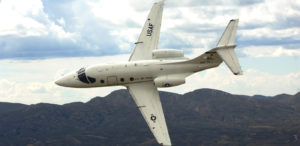
T-1A Jayhawk: Advanced trainer for airlift and tanker pilots (photo by Tech. Sgt. Matthew Hannen)
The T-1A Jayhawk is a medium-range, twin-engine jet trainer used in the advanced phase of specialized undergraduate pilot training for students selected to fly airlift or tanker aircraft. It is also used to support navigator training for the U.S. Air Force, Navy, Marine Corps and international services. The swept-wing T-1A is a military version of the Beech 400A. It has cockpit seating for an instructor and two students and is powered by twin turbofan engines capable of an operating speed of 538 mph. The T-1A differs from its commercial counterpart with structural enhancements that provide for increased bird strike resistance and an additional fuselage fuel tank.
KC-10 Extender, McGuire AFB, NJ
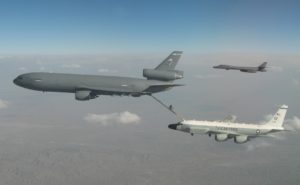 The KC-10 Extender is an Air Mobility Command advanced tanker and cargo aircraft designed to provide increased global mobility for U.S. armed forces. Although the KC-l0’s primary mission is aerial refueling, it can combine the tasks of a tanker and cargo aircraft by refueling fighters and simultaneously carry the fighter support personnel and equipment on overseas deployments. The KC-10 is also capable of transporting litter and ambulatory patients using patient support pallets during aeromedical evacuations.
The KC-10 Extender is an Air Mobility Command advanced tanker and cargo aircraft designed to provide increased global mobility for U.S. armed forces. Although the KC-l0’s primary mission is aerial refueling, it can combine the tasks of a tanker and cargo aircraft by refueling fighters and simultaneously carry the fighter support personnel and equipment on overseas deployments. The KC-10 is also capable of transporting litter and ambulatory patients using patient support pallets during aeromedical evacuations.
The KC-10 can transport up to 75 people and nearly 170,000 pounds (76,560 kilograms) of cargo a distance of about 4,400 miles (7,040 kilometers) unrefueled.
In addition to the three main DC-10 wing fuel tanks, the KC-10 has three large fuel tanks under the cargo floor, one under the forward lower cargo compartment, one in the center wing area and one under the rear compartment. Combined, the capacity of the six tanks carries more than 356,000 pounds (160,200 kilograms) of fuel – almost twice as much as the KC-135 Stratotanker.
C-2 Greyhound, Norfolk Naval Air Station
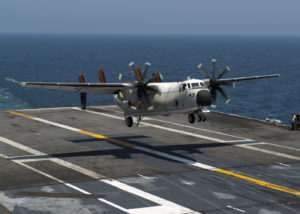
130724-N-GR168-024
ATLANTIC OCEAN (July 24, 2013) A C-2A Greyhound assigned to the Rawhides of Fleet Logistics Support Squadron (VRC) 40 lands on the flight deck of the aircraft carrier USS Harry S. Truman (CVN 75). Harry S. Truman is deployed as part of the Harry S. Truman Carrier Strike Group and will be supporting maritime security operations and theater security cooperation efforts in the U.S. 6th and 5th Fleet areas of responsibility. (U.S. Navy photo by Mass Communication Specialist 2nd Class Lyle H. Wilkie III/Released)
The Grumman C-2 Greyhound is a twin-engine, high-wing cargo aircraft, designed to carry supplies, mail, and passengers to and from aircraft carriers of the United States Navy. Its primary mission is carrier onboard delivery (COD). The aircraft provides critical logistics support to carrier strike groups. The aircraft is mainly used to transport high-priority cargo, mail, and passengers between carriers and shore bases, and can also deliver cargo like jet engines and special stores. Powered by two Allison T56 turboprop engines, the C-2A can deliver up to 10,000 pounds (4,500 kg) of cargo, passengers or both. It can also carry litter patients in medical evacuation missions. A cage system or transport stand restrains cargo during carrier launch and landing. The large aft cargo ramp and door and a powered winch allow straight-in rear cargo loading and unloading for fast turnaround. The Greyhound’s ability to airdrop supplies and personnel, fold its wings, and generate power for engine starting and other uses provide an operational versatility found in no other cargo aircraft.
E-2D Advanced Hawkeye
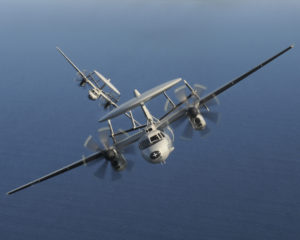
121120-N-ZZ999-008
VENTURA, Calif. (Nov. 20, 2012) E-2C Hawkeye aircraft assigned to the Wallbangers of Carrier Airborne Early Warning Squadron (VAW) 117 fly over the Pacific Ocean near Ventura, Calif. VAW-117 is a command and control and airborne early Warning Squadron dedicated to deliver time critical situational awareness to warfare commanders and coalition partners. (U.S. Navy photo by Command Master Chief Spike Call/Released)
The E-2D Advanced Hawkeye (AHE) is the newest variant of the E-2 aircraft platform; an all-weather, carrier capable tactical airborne early warning aircraft. It features a state-of-the-art radar with a two-generation leap in capability and upgraded aircraft systems that will improve supportability and increase readiness over the previous generation Hawkeye. The E-2D continues the Navy’s integrated war fighting legacy by providing broad area coverage resulting in broader range capabilities. With the E-2D’s enhanced ability to work in the littoral and over land, the platform provides a critical capability to protect our nation’s interests.
Beyond the battle group, the Hawkeye’s command and control capability makes it a multi-mission platform through its ability to coordinate concurrent missions that may arise during a single flight, to include: airborne strike, land force support, rescue operations, managing a reliable communications network between widely dispersed nodes and support for drug interdiction operations. The use of the new glass cockpit and tactical fourth operator display allows the five-person crew more flexibility in fulfilling these diverse missions.
UH-1 Iroquois
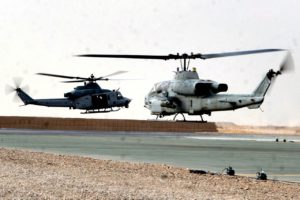
USMC AH-1 Super Cobra
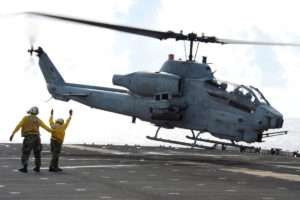
F-16 Fighting Falcon, Shaw AFB, SC
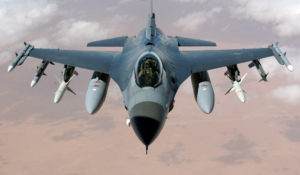 The F-16 Fighting Falcon is a compact, multi-role fighter aircraft. It is highly maneuverable and has proven itself in air-to-air combat and air-to-surface attack. It provides a relatively low-cost, high-performance weapon system for the United States and allied nations.
The F-16 Fighting Falcon is a compact, multi-role fighter aircraft. It is highly maneuverable and has proven itself in air-to-air combat and air-to-surface attack. It provides a relatively low-cost, high-performance weapon system for the United States and allied nations.
In an air combat role, the F-16’s maneuverability and combat radius (distance it can fly to enter air combat, stay, fight and return) exceed that of all potential threat fighter aircraft. It can locate targets in all weather conditions and detect low flying aircraft in radar ground clutter. In an air-to-surface role, the F-16 can fly more than 500 miles, deliver its weapons with superior accuracy, defend itself against enemy aircraft, and return to its starting point. An all-weather capability allows it to accurately deliver ordnance during non-visual bombing conditions.
C-130H Hercules, 757th Airlift Squadron, Youngstown Air Reserve Station
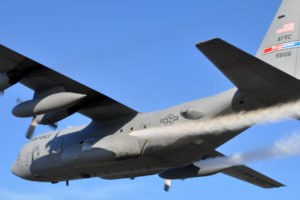 Flying C-130H’s equipped with palletized Modular Aerial Spray System, or MASS, units, 757th AS crews spray thousands of acres every spring, summer, and fall. Assigned to Air Force Reserve Command’s 910th Airlift Wing, the 757th AS is the only large-area, fixed-wing aerial spray unit in the US Department of Defense. Aircrews, maintainers, and a couple of the unit’s six entomologists—almost half of the insect specialists in the US Air Force—deploy more than twenty-five times a year for extended operations at locations ranging from southern Florida to Mountain Home AFB, Idaho, and from Parris Island, South Carolina, to Hill AFB, Utah.
Flying C-130H’s equipped with palletized Modular Aerial Spray System, or MASS, units, 757th AS crews spray thousands of acres every spring, summer, and fall. Assigned to Air Force Reserve Command’s 910th Airlift Wing, the 757th AS is the only large-area, fixed-wing aerial spray unit in the US Department of Defense. Aircrews, maintainers, and a couple of the unit’s six entomologists—almost half of the insect specialists in the US Air Force—deploy more than twenty-five times a year for extended operations at locations ranging from southern Florida to Mountain Home AFB, Idaho, and from Parris Island, South Carolina, to Hill AFB, Utah.

The B-52 is a long-range, heavy bomber that can perform a variety of missions. The bomber is capable of flying at high subsonic speeds at altitudes up to 50,000 feet. It can carry nuclear or precision guided conventional ordnance with worldwide precision navigation capability. In a conventional conflict, the B-52 can perform strategic attack, close-air support, air interdiction, offensive counter-air and maritime operations. Updated with modern technology the B-52 will be capable of delivering the full complement of joint developed weapons and will continue into the 21st century as an important element of our nation’s defenses. Current engineering analyses show the B-52’s life span to extend beyond the year 2040.
UH-60 Blackhawk
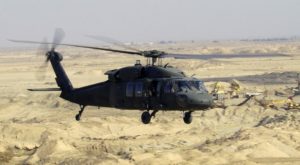
A US Army (USA) UH-60L Black hawk Helicopter flies a low-level mission over Iraq during Operation IRAQI FREEDOM.
The UH-60 (BLACK HAWK) is a twin turbine engine, single rotor, rotary wing helicopter. Primary mission capability of the helicopter is tactical transport of troops, supplies and equipment. Secondary missions include training, mobilization, development of new and improved concepts, and support of disaster relief. Its variants are in use with all 5 branches of the armed forces.
LUH-72 Lakota
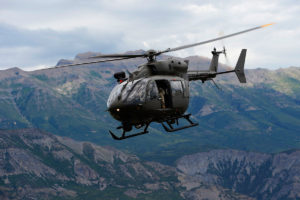 The LUH-72A Light Utility Helicopter (LUH) is a Commercial/Non-Developmental-Item, twin-engine helicopter with seating for two pilots, capable of transporting up to six passengers. The medical evacuation (MEDEVAC) configuration is equipped with two NATO standard litters and seating for a medical attendant and crew chief. Visual and instrument flight certified, the LUH-72A is equipped with a night-vision-compatible glass cockpit and modern communications and navigation avionics, including autopilot and dual Global Positioning Systems with Wide Area Augmentation System. Other aircraft configurations include Combat Training Center Opposing Forces and Observer/Controller, Security and Support, and VIP. Though not a warfighting aircraft, the LUH-72A is an inexpensive light helicopter that operates in permissive environments to meet Homeland Defense and Security, general support, reconnaissance, command and control operations, search and rescue, and training requirements worldwide
The LUH-72A Light Utility Helicopter (LUH) is a Commercial/Non-Developmental-Item, twin-engine helicopter with seating for two pilots, capable of transporting up to six passengers. The medical evacuation (MEDEVAC) configuration is equipped with two NATO standard litters and seating for a medical attendant and crew chief. Visual and instrument flight certified, the LUH-72A is equipped with a night-vision-compatible glass cockpit and modern communications and navigation avionics, including autopilot and dual Global Positioning Systems with Wide Area Augmentation System. Other aircraft configurations include Combat Training Center Opposing Forces and Observer/Controller, Security and Support, and VIP. Though not a warfighting aircraft, the LUH-72A is an inexpensive light helicopter that operates in permissive environments to meet Homeland Defense and Security, general support, reconnaissance, command and control operations, search and rescue, and training requirements worldwide
EA-18G Growler
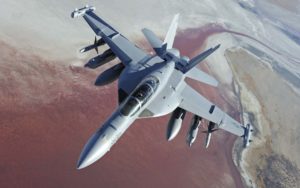 The Boeing EA-18G Growler is an American carrier-based electronic warfare aircraft, a specialized version of the two-seat F/A-18F Super Hornet. The EA-18G replaced the Northrop Grumman EA-6B Prowlers in service with the United States Navy. The Growler’s electronic warfare capability is primarily provided by Northrop Grumman. The EA-18G began production in 2007 and entered operational service with the US Navy in late 2009. The EA-18G combines the capability of the combat-proven Super Hornet with the latest AEA avionics suite evolved from the Improved Capability III (ICAP III) system. The EA-18G’s vast array of sensors and weapons provides the warfighter with a lethal and survivable weapon system to counter current and emerging threats. It’s capabilities include suppression of enemy air defenses, stand-off and escort jamming, non-traditional electronic attack, self protection and strike support.
The Boeing EA-18G Growler is an American carrier-based electronic warfare aircraft, a specialized version of the two-seat F/A-18F Super Hornet. The EA-18G replaced the Northrop Grumman EA-6B Prowlers in service with the United States Navy. The Growler’s electronic warfare capability is primarily provided by Northrop Grumman. The EA-18G began production in 2007 and entered operational service with the US Navy in late 2009. The EA-18G combines the capability of the combat-proven Super Hornet with the latest AEA avionics suite evolved from the Improved Capability III (ICAP III) system. The EA-18G’s vast array of sensors and weapons provides the warfighter with a lethal and survivable weapon system to counter current and emerging threats. It’s capabilities include suppression of enemy air defenses, stand-off and escort jamming, non-traditional electronic attack, self protection and strike support.
T-38 Talon
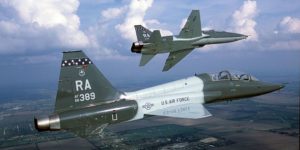 The T-38 Talon is a twin-engine, high-altitude, supersonic jet trainer used in a variety of roles because of its design, economy of operations, ease of maintenance, high performance and exceptional safety record. Air Education and Training Command is the primary user of the T-38 for joint specialized undergraduate pilot training. Air Combat Command, Air Force Materiel Command and the National Aeronautics and Space Administration also use the T-38 in various roles. The Talon first flew in 1959. More than 1,100 were delivered to the Air Force between 1961 and 1972 when production ended. As the T-38 fleet has aged, specific airframe, engine and system components have been modified or replaced.
The T-38 Talon is a twin-engine, high-altitude, supersonic jet trainer used in a variety of roles because of its design, economy of operations, ease of maintenance, high performance and exceptional safety record. Air Education and Training Command is the primary user of the T-38 for joint specialized undergraduate pilot training. Air Combat Command, Air Force Materiel Command and the National Aeronautics and Space Administration also use the T-38 in various roles. The Talon first flew in 1959. More than 1,100 were delivered to the Air Force between 1961 and 1972 when production ended. As the T-38 fleet has aged, specific airframe, engine and system components have been modified or replaced.
P-8 Poseidon
 The P-8A Poseidon (P-8A), the U.S. Navy’s newest maritime, patrol and reconnaissance aircraft is a multi-mission capable replacement aircraft for the legacy P-3C Orion. The P-8A is designed to improve an operator’s ability to conduct anti-submarine warfare; anti-surface warfare; and intelligence, surveillance, and reconnaissance missions.
The P-8A Poseidon (P-8A), the U.S. Navy’s newest maritime, patrol and reconnaissance aircraft is a multi-mission capable replacement aircraft for the legacy P-3C Orion. The P-8A is designed to improve an operator’s ability to conduct anti-submarine warfare; anti-surface warfare; and intelligence, surveillance, and reconnaissance missions.
A-10 Thunderbolt II (Warthog)
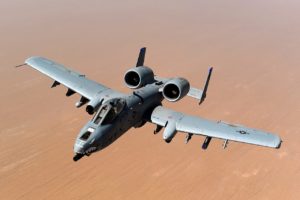 The Fairchild Republic A-10 Thunderbolt II is a single-seat, twin turbofan engine, straight wing jet aircraft developed by Fairchild-Republic for the United States Air Force (USAF). Commonly referred to by the nicknames “Warthog” or “Hog”, its official name comes from the Republic P-47 Thunderbolt, a World War II fighter-bomber effective at attacking ground targets. The A-10 was designed for close air support (CAS) of friendly ground troops, attacking armored vehicles and tanks, and providing quick-action support against enemy ground forces. It entered service in 1976 and is the only production-built aircraft that has served in the USAF that was designed solely for CAS.
The Fairchild Republic A-10 Thunderbolt II is a single-seat, twin turbofan engine, straight wing jet aircraft developed by Fairchild-Republic for the United States Air Force (USAF). Commonly referred to by the nicknames “Warthog” or “Hog”, its official name comes from the Republic P-47 Thunderbolt, a World War II fighter-bomber effective at attacking ground targets. The A-10 was designed for close air support (CAS) of friendly ground troops, attacking armored vehicles and tanks, and providing quick-action support against enemy ground forces. It entered service in 1976 and is the only production-built aircraft that has served in the USAF that was designed solely for CAS.
T-45C Goshawk
 The T-45 Goshawk, the Navy version of the British Aerospace Hawk aircraft, is used for intermediate and advanced portions of the Navy/Marine Corps pilot training program for jet carrier aviation and tactical strike missions. The T-45A has replaced the T-2 Buckeye trainer and the TA-4 trainer.
The T-45 Goshawk, the Navy version of the British Aerospace Hawk aircraft, is used for intermediate and advanced portions of the Navy/Marine Corps pilot training program for jet carrier aviation and tactical strike missions. The T-45A has replaced the T-2 Buckeye trainer and the TA-4 trainer.
HC-144A Ocean Sentry
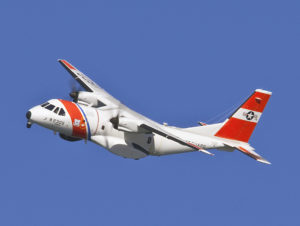 The EADS HC-144 Ocean Sentry is a medium-range, twin-engined aircraft used by the United States Coast Guard. The fixed-wing, turboprop aircraft has an endurance of more than 10 hours and an extensive sensor capability that helps the Coast Guard fulfill its maritime patrol, drug and migrant interdiction, disaster response, and search and rescue missions more effectively. The Ocean Sentry is particularly effective at locating objects in large search areas and vectoring other military, government and first responders to these locations. The aircraft has the capability to perform aerial delivery of search and rescue equipment, such as rafts, pumps and flares. Also, with its sophisticated command and control system, it can serve as a platform for an on-scene commander during homeland security missions.
The EADS HC-144 Ocean Sentry is a medium-range, twin-engined aircraft used by the United States Coast Guard. The fixed-wing, turboprop aircraft has an endurance of more than 10 hours and an extensive sensor capability that helps the Coast Guard fulfill its maritime patrol, drug and migrant interdiction, disaster response, and search and rescue missions more effectively. The Ocean Sentry is particularly effective at locating objects in large search areas and vectoring other military, government and first responders to these locations. The aircraft has the capability to perform aerial delivery of search and rescue equipment, such as rafts, pumps and flares. Also, with its sophisticated command and control system, it can serve as a platform for an on-scene commander during homeland security missions.
T-6 Texan II
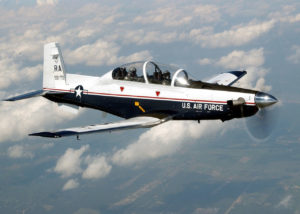 The T-6A Texan II is a single-engine, two-seat primary trainer designed to train Joint Primary Pilot Training, or JPPT, students in basic flying skills common to U.S. Air Force and Navy pilots. Stepped-tandem seating in the single cockpit places one crewmember in front of the other, with the student and instructor positions being interchangeable. A pilot may also fly the aircraft alone from the front seat. Pilots enter the T-6A cockpit through a side-opening, one-piece canopy that has demonstrated resistance to bird strikes at speeds up to 270 knots. The T-6A has a Pratt & Whitney Canada PT6A-68 turbo-prop engine that delivers 1,100 horsepower. The aircraft is fully aerobatic and features a pressurized cockpit with an anti-G system, ejection seat and an advanced avionics package with sunlight-readable liquid crystal displays.
The T-6A Texan II is a single-engine, two-seat primary trainer designed to train Joint Primary Pilot Training, or JPPT, students in basic flying skills common to U.S. Air Force and Navy pilots. Stepped-tandem seating in the single cockpit places one crewmember in front of the other, with the student and instructor positions being interchangeable. A pilot may also fly the aircraft alone from the front seat. Pilots enter the T-6A cockpit through a side-opening, one-piece canopy that has demonstrated resistance to bird strikes at speeds up to 270 knots. The T-6A has a Pratt & Whitney Canada PT6A-68 turbo-prop engine that delivers 1,100 horsepower. The aircraft is fully aerobatic and features a pressurized cockpit with an anti-G system, ejection seat and an advanced avionics package with sunlight-readable liquid crystal displays.
AH-64D Apache
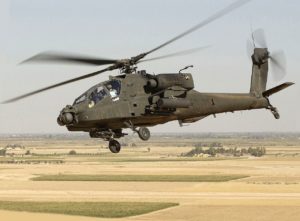 The AH-64 Apache is the world’s most advanced multi-role attack helicopter and is used by the U.S. Army and a growing number of international defense forces. Boeing has delivered more than 2,200 Apaches to customers around the world since the aircraft entered production. The U.S. Army Apache fleet has accumulated (as of July 2016) more than 4.2 million flight hours since the first AH-64A was delivered to the U.S. Army in January 1984.
The AH-64 Apache is the world’s most advanced multi-role attack helicopter and is used by the U.S. Army and a growing number of international defense forces. Boeing has delivered more than 2,200 Apaches to customers around the world since the aircraft entered production. The U.S. Army Apache fleet has accumulated (as of July 2016) more than 4.2 million flight hours since the first AH-64A was delivered to the U.S. Army in January 1984.
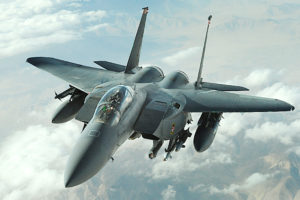
An F-15E Strike Eagle flies over Afghanistan. The F-15E’s primary role in Afghanistan is providing close-air support for ground troops. (U.S. Air Force photo/Staff Sgt. Aaron Allmon)
The F-15E Strike Eagle is a dual-role fighter designed to perform air-to-air and air-to-ground missions. An array of avionics and electronics systems gives the F-15E the capability to fight at low altitude, day or night, and in all weather. The aircraft uses two crew members, a pilot and a weapon systems officer. Previous models of the F-15 are assigned air-to-air roles; the “E” model is a dual-role fighter. It has the capability to fight its way to a target over long ranges, destroy enemy ground positions and fight its way out.
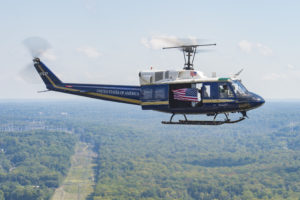
A UH-1N Iroquois flies an American Flag during the 2015 Joint Base Andrews Air Show, Sept. 19. The helicopter is currently assigned to the 1st Helicopter Squadron at JBA. (U.S. Air Force photo/Airman 1st Class Ryan J. Sonnier/Released)
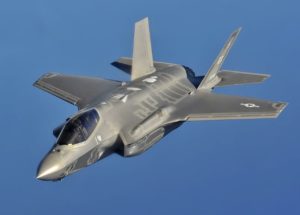 The F-35A is the U.S. Air Force’s latest fifth-generation fighter. It will replace the U.S. Air Force’s aging fleet of F-16 Fighting Falcons and A-10 Thunderbolt II’s, which have been the primary fighter aircraft for more than 20 years, and bring with it an enhanced capability to survive in the advanced threat environment in which it was designed to operate. With its aerodynamic performance and advanced integrated avionics, the F-35A will provide next-generation stealth, enhanced situational awareness, and reduced vulnerability for the United States and allied nations.
The F-35A is the U.S. Air Force’s latest fifth-generation fighter. It will replace the U.S. Air Force’s aging fleet of F-16 Fighting Falcons and A-10 Thunderbolt II’s, which have been the primary fighter aircraft for more than 20 years, and bring with it an enhanced capability to survive in the advanced threat environment in which it was designed to operate. With its aerodynamic performance and advanced integrated avionics, the F-35A will provide next-generation stealth, enhanced situational awareness, and reduced vulnerability for the United States and allied nations.